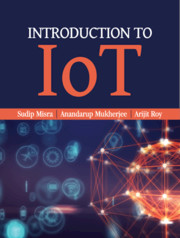4 - Emergence of IoT
Published online by Cambridge University Press: 09 January 2021
Summary
Learning Outcomes
After reading this chapter, the reader will be able to:
Explain the chronology for the evolution of Internet of Things (IoT)
Relate new concepts with concepts learned earlier to make a smooth transition to IoT
List the reasons for a prevailing universal networked paradigm, which is IoT
Compare and correlate IoT with its precursors such as WSN, M2M, and CPS
List the various enablers of IoT
Understand IoT networking components and various networking topologies
Recognize the unique features of IoT which set it apart from other similar paradigms
Introduction
The modern-day advent of network-connected devices has given rise to the popular paradigm of the Internet of Things (IoT). Each second, the present-day Internet allows massively heterogeneous traffic through it. This network traffic consists of images, videos, music, speech, text, numbers, binary codes, machine status, banking messages, data from sensors and actuators, healthcare data, data from vehicles, home automation system status and control messages, military communications, and many more. This huge variety of data is generated from a massive number of connected devices, which may be directly connected to the Internet or connected through gateway devices. According to statistics fromthe Information Handling Services [7], the total number of connected devices globally is estimated to be around 25 billion. This figure is projected to triple within a short span of 5 years by the year 2025. Figure 4.1 shows the global trend and projection for connected devices worldwide.
The traffic flowing through the Internet can be attributed to legacy systems as well as modern-day systems. The miniaturization of electronics and the cheap affordability of technology is resulting in a surge of connected devices, which in turn is leading to an explosion of traffic flowing through the Internet.
Points to ponder
“The Internet of Things (IoT) is the network of physical objects that contain embedded technology to communicate and sense or interact with their internal states or the external environment.“
—Gartner Research [5]One of the best examples of this explosion is the evolution of smartphones. In the late 1990’s, cellular technology was still expensive and which could be afforded only by a select few. Moreover, these particular devices had only the basic features of voice calling, text messaging, and sharing of low-quality multimedia.
- Type
- Chapter
- Information
- Introduction to IoT , pp. 75 - 96Publisher: Cambridge University PressPrint publication year: 2021

